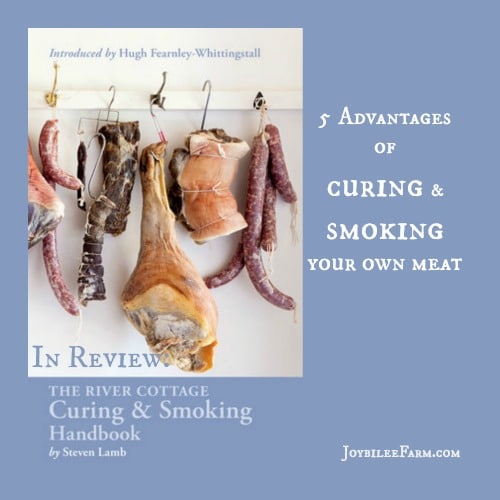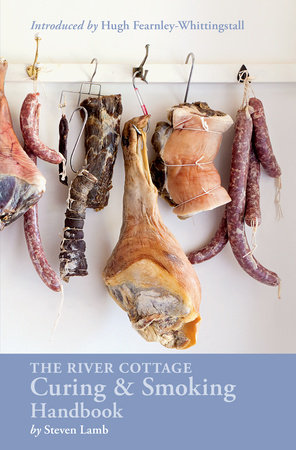5 Advantages of curing and smoking your own meat
If you are a homesteader and are looking for new ways to preserve the annual harvest, you’ll get lots of inspiration and workable recipes in The River Cottage Curing & Smoking Handbook.
Review: “The River Cottage Curing & Smoking Handbook” by Stephen Lamb. Ten Speed Press: Berkley, 2015.
5 stars
I read a book this week that really inspired me. It gave me a new reason to raise my own meat, ethically and organically. It fills the gap, for those flavours and textures I love in food — the smoky, spicy, and chewy sausages, the dry, salty meat — and the things I can actually make with my own hands in my kitchen. Stephen Lamb, in The River Cottage Curing & Smoking Handbook, unlocks the mystery behind classic smoked and cured meats that you’ll find in the best delis around Europe. I didn’t know I could actually make them myself.
I’ve always wanted to know how to take my gmo-free, pasture-raised meat from frozen cuts to succulent smoky meats worthy of the best pizza topping or bagel. This is the book I’ve needed all along. If you are a homesteader raising your own quality meat, poultry, fish, or cheese this is the book you’ve been waiting for. (And yes, there is a recipe for smoked cheese here.) If you have a local source for healthy meat, you’re a hunter or fisher, or you love to play in the kitchen with unusual techniques you’ll love this book. If you prefer Hamburger Helper™ and Shake ‘n’ Bake™ you might feel a bit overwhelmed with the recipes, but hey, everyone has to start somewhere.
One of the drawbacks of cultured meat is that it is always pork-based. Take a walk through the sausage and deli meat section of your local organic food store and read the labels. I did that last Friday at Choices Market in Kelowna. The first ingredient of every package I picked up – Pork. Now for those of you that raise pigs and love pork, that’s all fine. This book has lots of pork recipes. But my family doesn’t eat pork. Never has, except for a brief bacon fixation when my middle son was 15 till he left home. Once he left, so did the bacon.
So when I see those amazing Pinterest recipes of asparagus wrapped in bacon, I pin them anyway, knowing I’d never be able to actually make them. Isn’t that what Pinterest is for? Well, with this book by Stephen Lamb, that’s about to change.

The River Cottage Curing & Smoking Handbook teaches how you can now make bacon at home
Lamb reveals the secret to making bacon at home in just 10 days, using pork, (yes, but why would you have to use pork?). Once you know the step-by-step process, you can use the knowledge to substitute other meats, like lamb, goat, bear, or even beef. Beef bacon? Well, they sell turkey bacon here. See pages 138 to 143 for the well-illustrated beginner recipe that uses pork belly. There are recipes here for Canadian back bacon, too, using pork loin. Lamb claims this will be the best bacon you’ve ever tasted. It’s a very simple recipe with only 6 ingredients. It’s the technique that’s magical. Once you’ve tried it, I’m sure you’ll never go back to store-bought bacon with its high-end luxury price tag. Seriously, bacon’s gone up 25% here in just 3 months. Time to make your own, isn’t it?
But it’s not just about bacon. The book covers so many different meats, many that you may be growing on your homestead like lamb, goat, venison, duck, chicken, turkey, and fish. While the recipes are meat-specific and traditional, the techniques of curing and smoking are timeless and used to preserve the meat you have on hand, whatever that may be.
5 Advantages of curing and smoking your own meat
It allows you to use the entire animal for food
It is out of respect for the animals and for food that we attempt, as homesteaders, to use every part of the animal. The River Cottage Curing and Smoking Handbook show you how to use the tongue, the whole head, the heart, and the belly. These portions of a carcass are often discarded. In fact, if you send your animals to the abattoir, a requirement here if you want to sell the meat, you won’t even see these portions in the finished cut and wrapped packages. They are tossed from the kill floor. Get a copy of Lamb’s book, and you will no longer be participating in this waste.
Curing and smoking at home is done with healthier ingredients
You won’t find saltpetre (potassium nitrate) or sodium nitrate in the ingredient list of any of the recipes in this book. That’s a huge change. A few years ago, when I wanted to try making sausages, every recipe contained saltpetre. It is used to prevent the meat from darkening during the curing process. But it is a known carcinogen. Instead, this book uses no-additive salt in the recipes, making them a healthier alternative to store-bought meats, which continue to use sodium nitrate.
It follows traditional techniques and recipes
When you are making traditional food you want authentic ingredients. Now instead of shopping at the big box store and being told, “We don’t have what you want. Change what you want.” You will be able to create what you want for your traditional recipe from scratch, at home. Perfect self-sufficiency.
Making traditional meats from your own animals is a skill you can pass on to your children
If our parents and grandparents had kept the skills of curing and smoking alive, we wouldn’t need books like, “The River Cottage Curing & Smoking Handbook”. It’s for this reason that I’m glad books like this exist. Perhaps we can do a better job than our grandparents did in passing it to the next generation. Now we have a book, after all.
Curing and smoking meat at home saves money
Many of the recipes in the book will be cured for months, and others for just a few days. The longer processed meat is cured the more it costs. In the realm of food, processing time means money. Therefore traditional steps are substituted with chemicals that speed up the process but make the food less healthy. When you cure and smoke your own meat at home you save money and you create healthier food. It’s a win-win that will not only cover the cost of the book but maybe even the cost of that smokehouse you’ve been wanting to build on your homestead. At least you can tell your partner that.

What’s inside The River Cottage Curing & Smoking Handbook?
Let’s take a look inside The River Cottage Curing and Smoking Handbook. It is a small hardback that’s easy to handle – really the perfect size for a recipe book you’ll keep in the kitchen for a long time. Those large, unwieldy cookbooks with the hero pictures on alternate pages make inspiring reading but they are impractical to actually use on the counter while you are grabbing salt and molasses, and splashing olive oil. The layout is attractive with lots of information to ensure your success and inspiration. There are a few key pictures that demonstrate the step-by-step process of each technique, plus pictures of the finished products.
There are traditional recipes for food you’d find at the local deli, plus innovative recipes that will inspire your creativity.
What’s not in The River Cottage Curing & Smoking Handbook?
What you won’t find in the book are complete menus and serving suggestions. This is a technique book that shows you how to create an ingredient from scratch like bacon (p. 138) or salami (p. 166), using traditional recipes that are adapted to the homestead kitchen. Once you have the finished ingredients, whether that’s Hot Smoked Rose-cured Beef (p. 236) or Cider-cured Ham (p. 195), you can use it in your own recipes. Here’s where Pinterest might help. (I really want to try that rose-cured beef, once my rugosa roses are producing. It sounds amazing!)
If you are a homesteader, love to make food from scratch, and are looking for new ways to preserve the annual harvest, you’ll get lots of inspiration and workable recipes in the Curing and Smoking Handbook. But be warned, you may end up spending even more time on Pinterest, searching for DIY Smoke House plans and tantalizing bacon recipes.
Disclaimer: I received this book from Blogging for Books for this review. Nevertheless, this review represents my honest opinion of this book.



I had never considered that you could save money by smoking your own meat. After reading your reasoning, it makes sense why this would be a way to not spend a lot of money on meat that someone else smoked. My uncle likes to smoke his own meat for special occasions. I’ll have to ask him if it has been cheaper for him overall.
Smoking meat gives great results in terms of taste, but it’s also a great way to preserve meats. Not super easy to master, but definitely accessible.